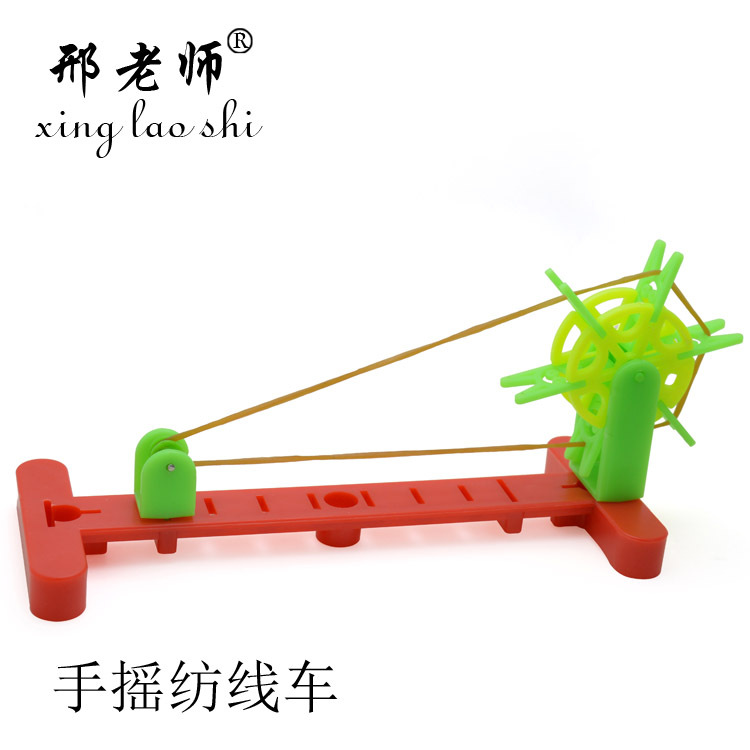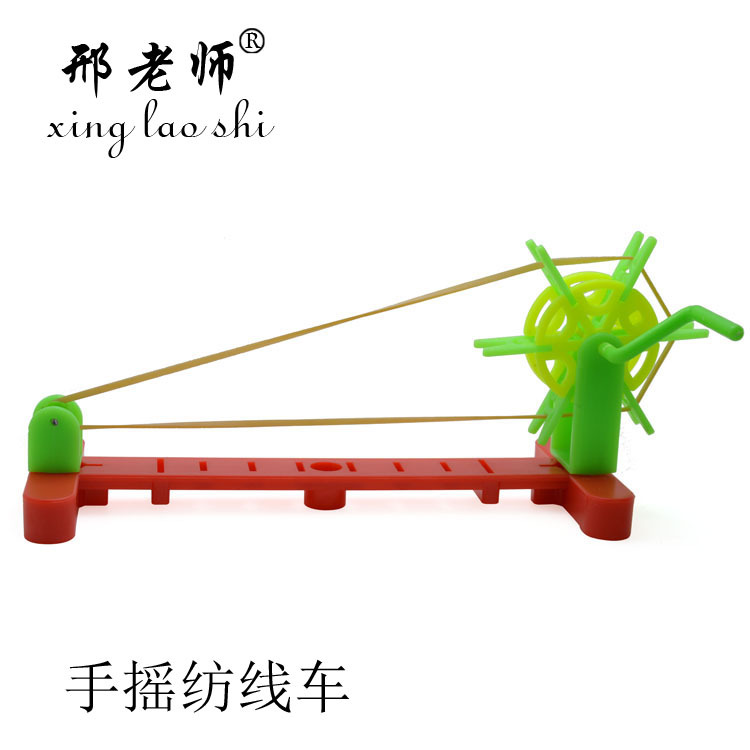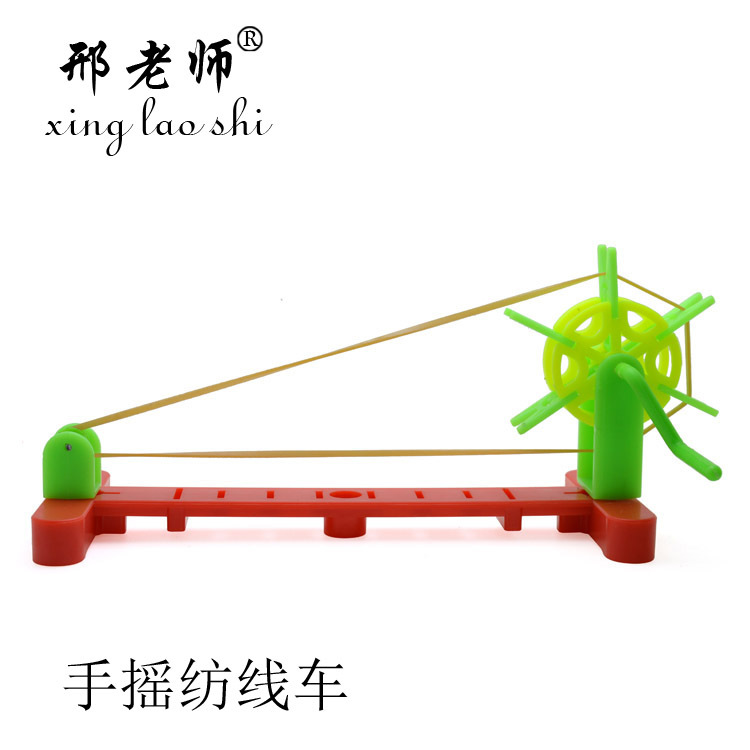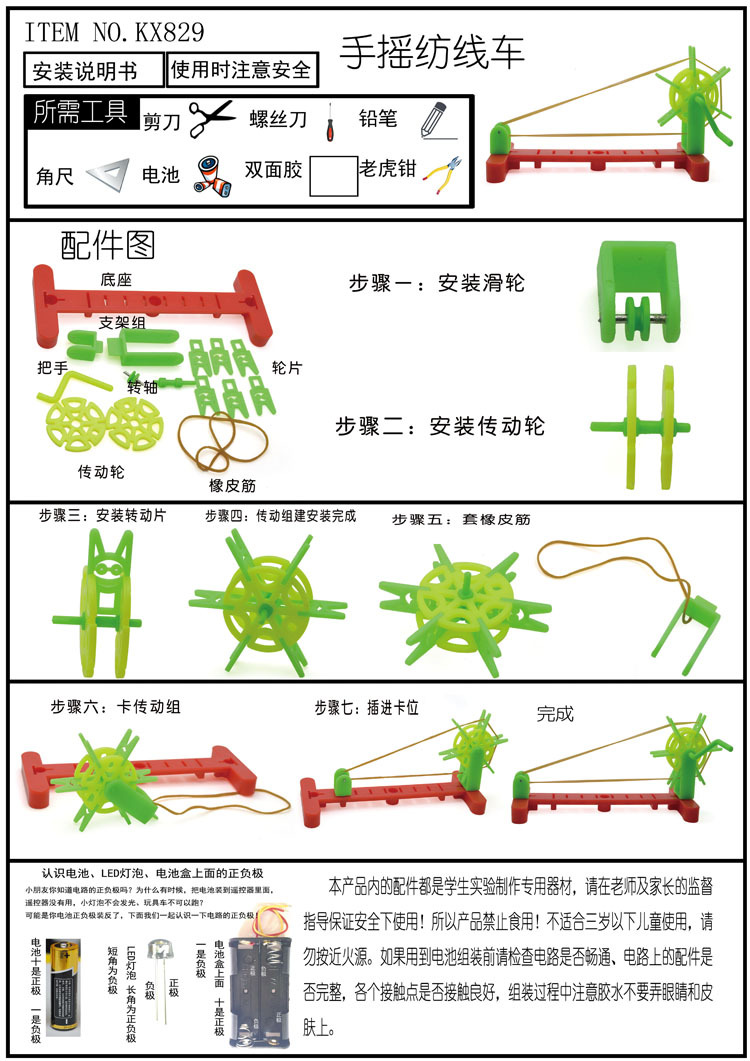X Email Mobile
| kx829 hand spining wheels | ¥0.0 | 9875 set available |
|
A new item has been added to your Shopping Cart. You now have items in your Shopping Cart.
Yiwu Henglin Co., Ltd. 10yr.
Main Products:Science and education toy science experiment model airplane novelty toy educational toy
Contacts:xinChat
Mobile:86-15858994086
E-mail: WeChat:15858994086
Address:70726 , 5 F, International Trade Mart (District 5).
Address:浙江省 金华市 金东区 天鸽智创园西区1栋,Jinhua City,Zhejiang Province
Related items
Product Name: Hand-crank Spinning Wheel
Product Number: KX829
Package: Packaging Bag
Product size: 6.5*8*18 CM
Packing Quantity: 400 PCS
Box Size: 60*40*55
Spinning wheels are devices that use fiber materials such as wool, cotton, linen, silk, etc. to produce yarn or thread. Spinning wheels typically have a wheel driven by hand or foot and a spindle. Spinning wheels became a common spinning tool in the Han Dynasty. The water-powered spinning wheel (water-powered large spinning wheel) was a water-powered spinning machine from ancient China. It was invented in the late Southern Song Dynasty and became popular in the Central Plains region during the Yuan Dynasty. It was one of the spinning machines in the world at that time.
Hand-cranked Spindle Course Presentation
Spinning wheels are devices that use fiber materials such as wool, cotton, linen, silk, etc. to produce yarn or thread. Spinning wheels typically have a wheel driven by hand or foot and a spindle. Spinning wheels became a common spinning tool in the Han Dynasty. The water-powered spinning wheel (water-powered large spinning wheel) is a water-powered spinning machine from ancient China. It was invented in the late Southern Song Dynasty and became popular in the Central Plains region during the Yuan Dynasty. It was one of the world's spinning machines at that time.
The water-driven large spinning machine with long fibers and drawing is mainly used for processing linen yarn and silk. The linen spinning machine is quite large, with a total length of about 9 meters and a height of 2 meters.Approximately 7 meters. It differs from the manual spinning wheel, equipped with 32 spindles, and has a more complex and massive structure, consisting of four parts: the spinning wheel, the drawing, the waterwheel, and the transmission device. It is driven by two leather belts to rotate 32 spindles. This spinning wheel is driven by water, and it has a high efficiency, adding 100 jin of hemp yarn per day. The water-driven large spinning wheel is a significant achievement in the application of natural power to textile machinery in ancient China. When it comes to spinning machines driven by water power, China was four centuries ahead of the West. The 'Spinning Wheel Picture' was painted by the great calligrapher Wang Ju-zheng. The layout is very clever, as he gives priority to the two fluttering threads. Surrounding the two threads, the scene presents many figures. To the right, a village woman sits on a small stool, cradling an infant to breastfeed, with a spinning wheel beside her, and her left hand is shaking the wheel. Breastfeeding should be backed up, but the village woman, due to her dual responsibilities, can only lean forward and slightly bend her waist. The author has shown his rich life experience in handling this image. In front of the old woman, both hands guide the thread ball, and her face reflects her weight and affection. At the same time, the author introduces another plot. Behind the village woman, there is a child sitting on the ground, holding a wooden pole, leading a toad, as if waiting for the infant to play on the ground. This picture is drawn with fine lines, and the spinning wheels are all depicted accurately, reflecting the high level of the Song Dynasty's folk paintings.
The Han Dynasty spinning wheel, although its structure is relatively simple, has increased the spinning effect by about twenty times compared to the traditional spinning wheel. This type of spinning wheel already uses a rope wheel transmission, proving that our country has been using rope wheel transmission in tool machines as early as two thousand years ago. With this spinning wheel, it is also possible to add twisting, and the yarn can be combined more evenly and consistently, regardless of the thickness of the silk or string. In 1972, a musical instrument called "Han Se" was excavated from the Mawangdui Han tomb in Changsha; its strings are made of sixteen single silk threads twisted together, and each thread is spun very evenly, able to produce harmonious melodies. It is likely that this spinning wheel was used for processing.
This spinning wheel, in addition to being able to spin yarn, also has an important role in producing the thread used for weaving. In the past, when using a spinning wheel, it was necessary to use an additional tool to twist the thread, but now that the spinning wheel exists, it can perform this task as well. This can significantly improve the production efficiency.
In the production process of spinning hemp, silk, cotton, and other materials, in order to improve quality and output, our laboring people have continuously created and made progress. Based on the hand-cranked spinning wheel, they invented the foot-powered spinning wheel and water-powered spinning wheel, further elevating China's spinning technology to a new height.
Experimental Objective: To understand the principle and mechanism of a spinning wheel.
Experimental Report: In spinning, it is necessary to concentrate multiple types of flax to meet its production requirements. Secondly, the transmission of the large spinning machine has adopted a collective transmission similar to the current dragon belt transmission. In modern machine spinning, apart from the new airflow spinning, the mechanism form still relies on the spindle and its transmission. However, due to the large mechanical power, there are more spindles and faster speeds. Comparing ancient spinning wheels with modern spinning machines, the modern transmission spindle's drum is the replacement of the bamboo wheel of the spinning wheel, and the new dragon belt transmission, and the leather string drive of the large spinning wheel are the same method. Their basic principles of spinning are consistent.
Hand-cranked Spindle Course Presentation
Spinning wheels are devices that use fiber materials such as wool, cotton, linen, silk, etc. to produce yarn or thread. Spinning wheels typically have a wheel driven by hand or foot and a spindle. Spinning wheels became a common spinning tool in the Han Dynasty. The water-powered spinning wheel (water-powered large spinning wheel) is a water-powered spinning machine from ancient China. It was invented in the late Southern Song Dynasty and became popular in the Central Plains region during the Yuan Dynasty. It was one of the world's spinning machines at that time.
The water-driven large spinning machine with long fibers and drawing is mainly used for processing linen yarn and silk. The linen spinning machine is quite large, with a total length of about 9 meters and a height of 2 meters.Approximately 7 meters. It differs from the manual spinning wheel, equipped with 32 spindles, and has a more complex and massive structure, consisting of four parts: the spinning wheel, the drawing, the waterwheel, and the transmission device. It is driven by two leather belts to rotate 32 spindles. This spinning wheel is driven by water, and it has a high efficiency, adding 100 jin of hemp yarn per day. The water-driven large spinning wheel is a significant achievement in the application of natural power to textile machinery in ancient China. When it comes to spinning machines driven by water power, China was four centuries ahead of the West. The 'Spinning Wheel Picture' was painted by the great calligrapher Wang Ju-zheng. The layout is very clever, as he gives priority to the two fluttering threads. Surrounding the two threads, the scene presents many figures. To the right, a village woman sits on a small stool, cradling an infant to breastfeed, with a spinning wheel beside her, and her left hand is shaking the wheel. Breastfeeding should be backed up, but the village woman, due to her dual responsibilities, can only lean forward and slightly bend her waist. The author has shown his rich life experience in handling this image. In front of the old woman, both hands guide the thread ball, and her face reflects her weight and affection. At the same time, the author introduces another plot. Behind the village woman, there is a child sitting on the ground, holding a wooden pole, leading a toad, as if waiting for the infant to play on the ground. This picture is drawn with fine lines, and the spinning wheels are all depicted accurately, reflecting the high level of the Song Dynasty's folk paintings.
The Han Dynasty spinning wheel, although its structure is relatively simple, has increased the spinning effect by about twenty times compared to the traditional spinning wheel. This type of spinning wheel already uses a rope wheel transmission, proving that our country has been using rope wheel transmission in tool machines as early as two thousand years ago. With this spinning wheel, it is also possible to add twisting, and the yarn can be combined more evenly and consistently, regardless of the thickness of the silk or string. In 1972, a musical instrument called "Han Se" was excavated from the Mawangdui Han tomb in Changsha; its strings are made of sixteen single silk threads twisted together, and each thread is spun very evenly, able to produce harmonious melodies. It is likely that this spinning wheel was used for processing.
This spinning wheel, in addition to being able to spin yarn, also has an important role in producing the thread used for weaving. In the past, when using a spinning wheel, it was necessary to use an additional tool to twist the thread, but now that the spinning wheel exists, it can perform this task as well. This can significantly improve the production efficiency.
In the production process of spinning hemp, silk, cotton, and other materials, in order to improve quality and output, our laboring people have continuously created and made progress. Based on the hand-cranked spinning wheel, they invented the foot-powered spinning wheel and water-powered spinning wheel, further elevating China's spinning technology to a new height.
Experimental Objective: To understand the principle and mechanism of a spinning wheel.
Experimental Report: In spinning, it is necessary to concentrate multiple types of flax to meet its production requirements. Secondly, the transmission of the large spinning machine has adopted a collective transmission similar to the current dragon belt transmission. In modern machine spinning, apart from the new airflow spinning, the mechanism form still relies on the spindle and its transmission. However, due to the large mechanical power, there are more spindles and faster speeds. Comparing ancient spinning wheels with modern spinning machines, the modern transmission spindle's drum is the replacement of the bamboo wheel of the spinning wheel, and the new dragon belt transmission, and the leather string drive of the large spinning wheel are the same method. Their basic principles of spinning are consistent.



Science and technology models mainly refer to land, sea, and air models. Science and technology model activities integrate science and competition, manual and brain work, and are deeply loved by a wide range of teenagers. Its main role is also to cultivate and improve the comprehensive manual innovation skills and high-quality of teenagers. Therefore, in the new form of deepening reform and vigorously promoting quality education at the turn of the century, actively carrying out science and technology model activities is an effective measure to implement quality education in an all-round way.
Expand Horizons and Enrich Scientific Knowledge
Science and technology model activities are rich in knowledge. For example, in the process of making and sailing model ships, students can understand why ships float, how ships maintain stability, why propellers generate power, and how ships move quickly. If we go deeper, students will encounter radio remote control transmitting and receiving machines, or master the principles of force, density, gravity, pressure, magnetic field, ship construction, engine construction, and radio material selection. Many of these knowledge are not in the "textbook" and are often needed in life. This will inspire students to think about other scientific and technological knowledge that comes from animal inspiration. Can you dare to imagine and make a science and technology model? Some may think of the inspiration from insects such as dragonflies and planes, or from fish shapes such as torpedoes, and can make some simple airplane models.In this way, students will come into contact with a variety of knowledge in science and technology model activities, which supplements a lot of book knowledge and opens up their horizons. It also enriches their extracurricular life and allows them to learn more about scientific knowledge.
Cultivate logical and thinking abilities
The technology model activity requires all participants to have a dialectical, holistic, and rigorous scientific approach in their thinking methods." "Although the sparrow is small, it has all the essential organs." The tiny technology model is a scaled-down version of large, real vehicles, ships, and airplanes; it is an integrated whole, where even a small change can affect the whole.
A model airplane that competes in duration in the air must go through two stages: high-speed climb and low-speed glide. The adjustment for the climb stage mainly involves the adjustment of the pull force line and the angle of attack after the wing is twisted. The position of the center of gravity, the installation angle of the wing and the horizontal tail, and the directional rudder all have an impact on the flight attitude of the airplane during climb, but these changes directly affect the performance of the model during the gliding stage. Therefore, in the design and adjustment, it is necessary to consider these stages comprehensively, as they have different loading conditions and solutions. For example, in the design and production of car, ship, and airplane models, the selection of materials for strength, rigidity, and weight is very serious. It is necessary to choose one of the best schemes from both. Therefore, in the scientific model activity, the thinking method requires adolescents to have a dialectical, holistic, and scientific approach. Otherwise, a small mistake can make the performance of the scientific model worse or even lead to failure.
It can be seen that the initial thinking of people begins with actions. The thinking characteristics of students are mainly in the form of concrete image thinking, and thinking cannot be separated from images and actions. In the process of operation activities, students need to move their eyes, move their hands, and think with their brains, speak with their mouths, so that the external operation process and the internal intellectual activities of dialectical, holistic, scientific, etc. are organically combined, which has effectively promoted their thinking development.
Three Cultivate Good Habits
Science and technology model activities are beneficial for shaping students' good personalities, cultivating their strong willpower and spirit of innovation, as well as their attention to detail and patience, forming a rigorous scientific attitude in doing things.
1. Scientific scheduling of time. Students face homework and various interests, talent cultivation, all need a certain amount of time and energy. Students must scientifically and reasonably arrange their time to achieve order and efficiency, without being overwhelmed.
2, having a beginning and an end. Nowadays, most students are only children, afraid of suffering and lack of perseverance, often give up halfway. If they choose activities that require them to use their hands and brains, let them try their best to complete a science and technology model work, their interest will rise again, because they all love to play with dynamic toys. From this perspective, it will also make them gradually overcome the laziness in the process of making, and persist in completing their own masterpieces. Thus, it also cultivates their habit of having a beginning and an end.
3, Collective Spirit. Students work together to design, create, and compete, helping, comparing, and learning from each other. This fosters a collective spirit among students, making them consider others and learn how to get along with others. In the socialist market economy, this collective spirit is essential for working together with others to create great achievements. The era of isolating themselves to boil pitch like Marie and Pierre Curie is no longer. Now, the society needs the cooperation of talent groups like the Apollo Moon Landing Project to transform the world and create the future.
Four: Stimulate students' interest in exploring the field of science and technology
A scientist or inventor, without a doubt, develops a profound interest in the things they love, and then explores and studies them, eventually achieving significant results in that field. Now, by having students create and assemble technology models, we allow them to understand the formation of power, the generation of buoyancy, and the effects of magnetic fields, laying a solid foundation for their future research and exploration in this area. This also sows the seeds of success.
In conclusion: actively developing science and technology model activities is an effective measure to implement quality education in schools, cultivate students' comprehensive development in morality, intelligence, physical, beauty, and labor, and improve their comprehensive quality. It is also an effective measure to implement the spirit of the opinions on strengthening popular science work issued by the Central Committee of the Communist Party of China and the State Council, as well as the National Fitness Program, and to fully implement the "Science and Education Revitalize the Country" strategy proposed by the Party's 15th National Congress.
Update time:
TOP